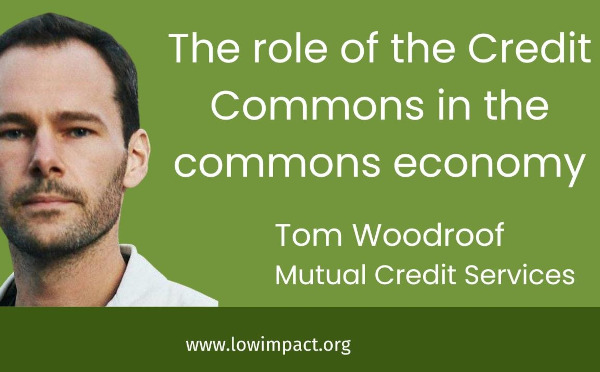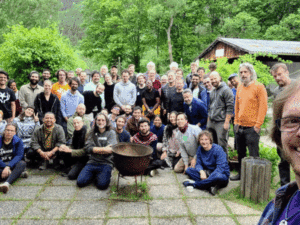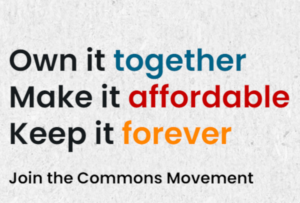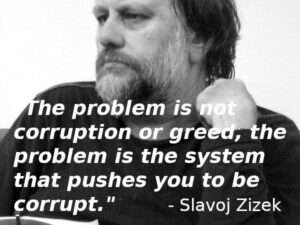The role of the Credit Commons in the commons economy: Tom Woodroof of Mutual Credit Services

Dave Darby of Lowimpact.org and Stroud Commons talks with Tom Woodroof of Local Loop Merseyside and Mutual Credit Services about the Credit Commons – a way to federate different groups all over the world that are building the commons economy (because you can’t get everything you need from just your community) – but it does it without centralised control. I want to get more details from Tom about this world-changing initiative.
Dave: I’m talking to you from Stroud, where a group of us are trying to build the commons economy, and I know you’re doing something very interesting, and related, in Liverpool, which we can touch on today, but maybe we can talk about that in more detail another time. In Stroud we have the beginnings of a housing commons and climbing commons, and there have been conversations about a water commons, land commons, food commons, energy commons. We’ve got some top specialists, ready to go. Now we can’t really have a thriving commons economy using bank-issued, debt-based money. We need a credit commons to be at the core of it, don’t we?
Tom: the powerful thing about that is the mutual interdependence – bringing people together with infrastructure, and improving their lives, and as you say, if we do that using the existing financial system – if we use the tools of financial capitalism to build the commons, it will be self-limiting if not outright self-defeating. We need a set of new financial tools to build the commons economy most effectively.
Dave: it’s no good if the credit commons is only understood in the academic, uber-techie world. It has to be understood in communities, so that it can be implemented in communities. It needs to be widely adopted doesn’t it?
Tom: exactly. There has to be a meaningful process of co-design. It’s one thing to have technical specialists, but if it’s irrelevant to actual communities who are doing commoning, we’re not going to get very far. Mutual Credit Services (MCS) try to synthesise the best thinking we can find, from tech, economics, governance / political economy etc, and we try to bring that expertise to communities, and work with them using their local expertise, to co-design something that’s going to work for them.
Dave: right, let’s get into some questions, and for some, you can just point me at online sources of information. So first, what is it? Can we explain the credit commons in terms the layperson can understand?
Tom: there’s a distinction to be made. First there’s the Credit Commons as a vision of an entirely new economic system – a commons system, with a commons financial system supporting it. And then there’s the Credit Commons Protocol, which is one of the tools that will be part of this new commons financial system. That’s an important distinction to draw. When we started out with MCS, we started with the protocol because we knew Matthew Slater, and he’d had this wonderful idea around attempting to overcome the limitations of previous mutual credit systems around scalability and decentralisation. We started out thinking ‘this is our tool. This is how we’re going to change the world – this idea of federated mutual credit ledgers implemented via this thing called the Credit Commons Protocol. What we’ve realised over the last few years though, is that there are going to have to be many other tools. You can’t change the global economy with just one tool. Yes, the Credit Commons Protocol is necessary, but there are lots of other tools for supporting the financial infrastructure of the commons. I know that on Lowimpact, you’ve written about some of these – things like Credit Clearing, Use-credit Obligations, Mutual Credit etc., which are also essential for underpinning the commons economy.
Dave: do you see the Credit Commons as just another sector of the economy? There’ll be a housing commons, land commons, energy commons. Is the Credit Commons just commoning the finance sector?
Tom: I don’t think that’s the best way to look at it, because it’s hard to think of any sector of the economy that isn’t reliant in some way on finance – so it’s not just another sector that you can talk about in isolation, or that you can silo off and say, ‘we’ve done housing, we’ve done energy, we’re doing money next’. It cuts across everything. It’s unfortunate in many ways – universities, or care, shouldn’t be run as for-profit businesses. Decisions about education and care (and many other things) shouldn’t be made on the basis of financial return. But that’s where we’re at. The silver lining is that if we can do interesting things with finance, you can end up talking to people in all different parts of the economy.
Dave: so it’s more like the nervous system of the entire commons economy, and has fingers in every sector?
Tom: that’s a nice metaphor. Or you could think of it as a type of substrate.
Dave: I was recently reading about the late 19th/early 20th century – communists wanted large-scale centralised industry. Anarchists wanted small-scale and decentralised industry. The anarchists lost – one reason that I’ve read was that the small and decentralised businesses weren’t connected/didn’t have a united front. How will small businesses be connected in a commons economy – via the credit commons protocol? If so, what does that mean exactly?
Tom: because the Credit Commons Protocol is a protocol for mutual credit, so some small businesses will be connected via mutual credit – but in Western economies, where supply chains are often long and linear, without circularity of trade, the number of businesses that will be suitable for a mutual credit network will be relatively small. This is where the need for these other tools comes in. with Local Loop Merseyside, for example, we start with credit clearing, with which we’re able to give a large number of businesses a gateway into the Credit Commons world. So there’s a variety of ways that businesses can be connected in this new economy. We don’t necessarily start with the Credit Commons Protocol – it’s about bringing networks of small businesses together, sharing some information about their trading, and using the tools we’ve got to improve their trading experience.
Dave: and credit clearing is easier for small businesses to understand, isn’t it?
Tom: yes, and we can bring large numbers of small businesses together quickly to begin to act a bit more cohesively – with a bit more solidarity, and receive pretty immediate, direct financial rewards for doing so. That will open up even more opportunities for collaboration.
Dave: credit clearing as a ‘gateway drug’ to the Credit Commons? Then mutual credit can come later, when there’s more trust?
Tom: right. Mutual credit is almost the last thing you do. You can get a long way, changing the way the economy works, using network science techniques – long before you start asking difficult questions about the nature of money and suggesting alternatives, simply by analysing trading and debt networks. The nice thing about that is that you’re not calling on people to question their beliefs about money, and to learn about new financial instruments. You can of course build the appetite for that, and collect information about the local economy that allows you to do a confident co-design process. This will make mutual credit more likely to succeed further down the line.
Dave: OK, so let’s focus on the Credit Commons as the money system of the commons economy. So what’s the Credit Commons Protocol? Where does that fit in?
Tom: the CC Protocol is a ledger for keeping track of exchanges.
Dave: like an accounting system?
Tom: exactly – it’s a system for accounting for exchange. For example, if I buy something from you, and we both have an account in a particular Credit Commons ledger, the numbers in your account go up, and the numbers in my account go down. It captures the fact that that exchange has taken place, the exchange was given a price, and the records need to be updated.
Dave: it shows who’s done what for whom?
Tom: effectively, yes – it’s a record of the exchanges in an economy, that participants have agreed will be tracked by this ledger system.
Dave: OK, so if you’ve got a business network in your town, and they want to operate together using mutual credit, they’d build that network on a Credit Commons ledger? Is that right?
Tom: the network building itself is much more of a community process. It’s about going out and talking with people, to find out who’s trading with who – finding the conditions under which a mutual credit scheme could make things better. Once you’ve got to that stage, you can set up a ledger, and businesses can have an account. We also have to build a way for them to interact with the ledger that’s user-friendly, intuitive, and speaks to their existing accounting software. Generally, make it as easy for them as possible to start using.
Dave: I want to come back to this. I want to talk a bit more about definition and benefits first, and then talk about actually getting things going in communities.
Tom: there’s one more important thing to say about the CC Protocol – that it can do recursive federation. Matthew Slater’s insight was that mutual credit schemes are based on trust – but trust doesn’t scale. So previous mutual credit schemes either had to stay small and trust-based, and remain genuinely mutual, but won’t support enough economic diversity to bring about very much real change – so they stay marginal. Or they go the way that Wir Bank in Switzerland went (it’s been going for about 100 years now). They got big (about 1% of Swiss GDP) – but there’s almost no mutuality involved. In order to scale up, they massively centralised, so that it’s now more like a private currency, run by a bank. That was the choice they had – stay small and mutual, with negligible impact, or have a big impact, but lose the mutuality. The point of the Credit Commons Protocol is that you can achieve both scale and decentralisation through a recursive federation structure.
Dave: so that’s the main problem it solves – how to move towards a global commons economy without losing local autonomy?
Tom: I wouldn’t go so far as to say it solves it, because there’s a tension there. Ultimately, local and decentralised does mean losing some economies of scale. The CC Protocol attempts to strike a balance between those competing forces – attempting to keep local mutual credit groups quite small, but federate them into a larger network of networks that can have some serious economic clout without being melded into one giant centralised network.
Dave: I want to talk a bit more about the protocol. A lot of people will have no idea what that means. The way it was once explained to me was that it’s a bit like the rules of chess, so that people are able to connect to play chess, as long as they understand the rules. Nobody owns the rules of chess – they’re just out there, and people can use them to connect with each other. But what does it look like and how can people in the commons economy engage with it / use it?
Tom: the important thing about having a protocol is that at least we can agree the terms of engagement. If we’re going to exchange with each other, and to keep score, we have to agree about how we keep score. Otherwise you’ll get all sorts of free-riding, arguments etc. You have to say – these are the rules, like chess, because if someone turns up with a completely different idea about what chess is, if you try to play chess with them, it’s not going to work.
Dave: so the protocol is the rules of exchange in the Credit Commons?
Tom: exactly – to make it very clear and unambiguous how the accounting for exchange takes place. For it to be useful to businesses, you need some layers on top of it. You need some kind of application – maybe a mobile app, which can speak the language of the CC Protocol, and get the protocol to do certain things, like update a balance in the ledger, in a way that’s intuitive to the user, and they don’t have to worry about how it works.
Dave: that’s exactly it – people don’t want to know about the nuts & bolts of how it works. It has to be intuitive. If it’s on a simple app, that’s even better. So does this app exist?
Tom: yeah, we’ve been building a mutual credit app for a co-operative network in Sweden, and we’ve done a version of it for a group in Vermont in the US. It’s a pretty straightforward app. The member businesses produce things for sale, they upload them to the app, there’s a shop, other members come to the shop, put items in their basket, press a button, and assuming the transaction goes through successfully, both members’ balances will be amended. That’s powered by the Credit Commons Protocol.
Dave: I’m thinking of Stroud. Social aspects first – you approach businesses and business networks, build a trading network and introduce them to the app?
Tom: it’s not just the appetite for collaboration. You have to find the right network structures. Even if there’s lots of appetite for collaboration, if there’s no actual circularity in the local trading network, it’s going to get stuck, because members will very quickly get to their positive or negative limits, and be unable to do any more trading, and so the system stops working. This is one of the things the CC Protocol does – it doesn’t just keep track of balances, it checks members balance limits, and prevents transactions that violate those limits. So you don’t just need high trust and collaboration, you need circularity of trade within the network, to allow members to buy and sell, without becoming stuck at their limits.
Dave: OK, so let’s talk a bit more about the benefits, and then talk about how we can get things going in towns/communities. Are there any alternative / similar approaches, what are they, and why is the Credit Commons better?
Tom: I’m guessing you’re talking about complementary / local currencies? The way they work is that they collect fiat money – pounds in the UK, put them in a bank account, and for every pound they have in the bank account, they issue one pound of local currency. There are lots of problems with that, but the main one is that they’re not actually creating any new means of payment in the local economy. For every pound of local currency, you’ve got to have a real pound in the bank.
Dave: it isn’t separate from the current banking system is it?
Tom: no, it does nothing to decouple you from the banking system, and there’s also no real obvious practical reason why anyone would accept it, apart from liking the ideology of it or the novelty of it. There’s no real incentive for businesses to accept it or for consumers to spend it. Most of the local currency experiments around the UK have failed.
Dave: I was thinking that the Credit Commons might have an environmental benefit, in that it might have a localisation tendency. Is it true that transaction fees will be slightly higher for each layer, representing geographical distance, that a transaction has to go through? So if the Credit Commons grows to encompass more of the world, is it right that transaction fees will be lower the more local a transaction is?
Tom: that could be part of it, although I’m not sure it will be decisive. I think there will be lots of powerful feedback loops towards localisation when it starts to take off at scale. Local networks will have transaction fees associated with them, and they’ll be part of a larger network, with another transaction fee for passing through that larger geographical scale. That will give a small incentive to trade locally, but if what you need is on the other side of the country, and you really need it, you’re probably going to pay the transaction fee even if it’s more than for a local trade. I think what’s going to be the real impact on localisation and supply chains is the fact that in local business networks there’s a high density flow of goods and services, which means a really dense invoice / debt network, which increases the potential for gridlock – businesses unable to pay because they haven’t been paid. The denser your local trade, the more likely that is to happen. There will be bottlenecks, traffic jams, queues – all kinds of gridlock. The result of that is that businesses get paid late – and we know that late payments are a huge problem for small businesses (it was even in the Labour Party manifesto). We’ve found that if we encourage local trade without taking this into consideration, it’s going to make local trading conditions worse – which could create a backlash, turning people against local trade. What’s great about credit clearing is that it eliminates those gridlocks. The denser the trading networks, the more debt you can eliminate without the need for money. We’ve seen lots of unblocking of any kind of gridlocks, so we can confidently say to small businesses for the first time, ‘if you do more trade locally, and you do credit clearing, you’ll not only be building your local economy, you’ll have a better experience’. I don’t think that’s been true before. So the de-risking of local trade, and then turning that risk into a positive incentive (because the more local your trade, the more you can clear without money) can be transformative.
Dave: so we’re back to the idea of credit clearing as the gateway, the first step.
Tom: exactly.
Dave: and you’re doing that in Liverpool. So credit clearing lends itself to big cities rather than small towns – is that right?
Tom: I think in the first instance, yes. I don’t yet know the smallest area you could expect to have a viable credit clearing network. It depends – some large towns don’t have much trade, some small ones have a huge amount. But we’ll find out. It makes sense to start in a decent-sized city like Liverpool, but we’ll find out. There might be places much smaller than Merseyside that have the critical mass of trade in order for credit clearing to make sense. What’s also true is that once you’ve done credit clearing, the next step on the roadmap is this thing called liquidity injection, which is where you make targeted payments within the network.
Dave: where do those targeted payments come from?
Tom: that’s the next question. The way credit clearing works is first to clear as much debt as possible without making any payments. You find the loops in the network and just cancel a lot of the debt. That’s a great place to start – very low risk. The problem is, a bit like mutual credit, it’s not going to work for everyone. Unless you do a lot of buying and selling locally, and you’re in a dense trading structure, you’re not going to be in any loops, and we’re not going to be able to clear any debt for you with credit clearing.
Dave: so plumbers tend to be small, local businesses, which is great. But where do they get their plumbing supplies from? There aren’t many local plumbing suppliers or manufacturers – they’re big.
Tom: yes, that’s an argument for doing credit clearing in a large city. You’re more likely to find enough local enterprise for the whole thing to make sense. But we still can’t promise that everyone is going to benefit from it. It will benefit the most well-connected businesses. Many businesses will be on the periphery, not part of any loops, and they won’t benefit from credit clearing. And so to reach that periphery, we use liquidity injection. When we’ve spread credit clearing as far as we can, without using any money, we can then look at eliminating debt that can’t be cleared with credit clearing. Then we look at the amount of money in the network – either the working capital of the businesses, or we crowdfund, or the local authority puts up some money – and we work out the most efficient use of that money within the network, rather than doing it in an uncoordinated way. That enables you to reach the network periphery in a way that credit clearing can’t, and it also allows you to operate at a much smaller scale. In Liverpool we expect to start a credit clearing network with at least 100 businesses. Once we’ve got liquidity injection going, it will make sense for even small towns to have a Local Loop system.
Dave: is this all part of a package that MCS can provide for a town?
Tom: that’s the direction we’re heading in, yes.
Dave: and do you have any more information you can point to about liquidity injection?
Tom: there’s almost nothing out there at the moment. That’s on the to do list. But to bring it back to the Credit Commons – these are two tools I’d definitely bracket under the Credit Commons: credit clearing and liquidity injection. The question is – what’s next? The easiest thing for liquidity injection is fiat/pounds. Everyone understands them, and if you say to someone: ‘you’ll get paid faster, in pounds’, they’ll be happy. Then the question is: how do we substitute the pounds we’re using in the network with use-credit obligations and mutual credit. Where are the parts of the network where we can say ‘there’s an appetite for collaboration, there’s enough circularity, there’s an anchor institution’, so we can carefully introduce mutual credit / use-credit obligations that will start to displace the need for fiat? That’s the point at which we’d start using the Credit Commons Protocol.
Dave: I’ll link to more information about credit clearing, mutual credit, use-credit obligations – but I also want to talk more about the connections between those tools, and their interoperability with the Credit Commons Protocol, and how we start to take this forward to build the Credit Commons.
Tom: I guess I’ve talked about the sequence of tools we’re employing with Local Loop. That’s credit clearing, then liquidity injection with fiat, then use-credit obligations and mutual credit. The point is that we’ve built Local Loop very much to serve SMEs. It’s a business network, so it has a commercial flavour – it’s about late payments, cashflow, interoperability with existing accounting systems etc. But this is only one part of the economy. In Stroud you’re looking at a housing commons, energy commons etc., which is much more about community building, smaller scale and with an activist feel. But you’re still intending to use Credit Commons financial tools to do what you’re doing. So at some point we can meet in the middle and start to change the entire economy. For example, it would be great when we can bring a Local Loop to Stroud and a housing commons to Liverpool. We’re working at both ends of this spectrum, and the question of what’s in the middle is a very interesting one.
Dave: here’s a different way of asking the question. I understand that at some point, Stroud Commons can have a Credit Commons ledger, where businesses in Stroud can trade with each other using mutual credit, which isn’t bank money, so it can’t be sucked out of Stroud. But we’re also building commons in housing, energy, land, leisure using vouchers – and I understand that these vouchers can be on the Credit Commons ledger too. Could you say a bit more about how that would work?
Tom: sure – so, the rent vouchers that you’re using for the housing commons in Stroud: that’s a flavour of a use-credit obligation. And because the Credit Commons Protocol is a ledger protocol, it’s perfectly capable of keeping track of use-credit obligations / vouchers – whatever you want to call them. At the moment, I understand you’re just using a spreadsheet?
Dave: yes.
Tom: OK, so because it’s small scale, informal, and you all know each other, a spreadsheet is the easiest thing to use. Once we start getting more houses into the commons, and we want to scale up and formalise, the Credit Commons Protocol will probably be the technology through which we track rent-credit obligations – what’s held by investors, tenants etc. The CC Protocol will be able to handle that, just as well as it handles the Swedish mutual credit network. You’re probably going to have an app, with an easy user interface, which tells you how many rent credits you’ve got in your wallet, and allow you to pay your rent with credits, buy more credits etc. When you pay your rent with credits, your balance will go down, and the balance of Stroud Housing Commons account will go up.
Dave: so once we’ve got the housing commons going using spreadsheets, the next step will be to talk with MCS about getting everything onto the Credit Commons ledger?
Tom: exactly. Then after that, another thing that I find interesting – in the middle ground between the commons movement and business networks is something called High Street vouchers. In Liverpool we’re all about business-to-business networks (B2B), but there’s also business-to-customer (B2C) – High Street retail. We’ve got a whole model around small retailers issuing vouchers, which is effectively a type of use-credit obligation too.
Dave: and all this is on the Credit Commons ledger too?
Tom: yes.
Dave: OK, so it’s getting quite mind-blowing. It’s quite comprehensive then?
Tom: if you’re trying to keep track of exchange, whether that’s in B2B mutual credit, or any peer-to-peer mutual credit, or in rent-credit obligations in the housing commons, or in B2C High Street vouchers, the Credit Commons Protocol can keep track of it.
Dave: so it could all interact so that eventually, employees of businesses in a network could receive some wages in mutual credit, tenants of housing commons could buy rent vouchers with mutual credit, people could buy High Street vouchers with mutual credit, and Liverpool and Stroud could be connected to your networks in Sweden and Vermont, and we could start to build a global network (albeit a sparse one for now), that we could grow.
Tom: that’s the ambition – with the tools we’ve got, we can address an enormous range of economic conditions, in a way that brings immediate benefits, but also drives the systemic change we’re working towards. The vision for this is that you’ll have a wallet app on your phone, and let’s say you’re a business – it enables you to add your invoices so that you can do credit clearing. You’re also part of a mutual credit network within that larger clearing network, so you have a B2B mutual credit balance. In other parts of your life, you’re also a consumer, so you have a balance showing how many local retail vouchers you have, and then you also have a balance that shows your rent credit obligations as a tenant of the local housing commons or your energy vouchers in the local energy commons. We’d like this to be one app with different modules/accounts, all interoperable.
Dave: it sounds as though it might need some training to be able to use all this? Or is it all intuitive?
Tom: it doesn’t exist yet, so we’re a way off needing training. Until we have an all-singing, all-dancing system, we need local instances of much lower ambition – like housing commons in Stroud and Local Loop in Liverpool. We’ve got to make those fly first, and learn lessons from them. As we add and integrate different sectors of the economy, we have to take small, careful steps towards proof of concept.
Dave: what I’m hearing is ‘be patient – and get the housing commons built’.
Tom: yes.
Dave: but there will be easy-to-use apps – people won’t have to get involved with code or anything complicated?
Tom: not at all.
Dave: and the app will need an API to talk to the protocol – and again, people won’t need to know anything about that?
Tom: no – MCS’s job is to design software that anyone can use.
Dave: so at the moment, we’re trying to build parts of a jigsaw, before we can start thinking about putting the jigsaw together?
Tom: yes – we’re still trying to show that the component parts can work well, before bringing them all together. Yes, we’ve got a roadmap, and we want to get to federation as soon as we possibly can, but one step at a time. We’ve come a long way, and things are becoming much clearer.
Dave: as we progress, we can provide manuals, step-by-step guides etc. so that others can replicate the models in any town?
Tom: yes – so instead of scaling up in the usual sense, we learn lessons, and replicate the components in other towns and cities – adapted for the local situation, but without having to reinvent the wheel. Then we can network/federate different locations together. That’s consistent with Damon Centola’s theory of behaviour change. In a nutshell, he says that these things are not going to go viral. Local Loops and commons organisations won’t start to spring up as if by magic all over the world. Once Local Loop is up and running in Merseyside, the next obvious places will be Manchester and Lancashire.
Dave: and Bristol & Bath in the south-west (the nearest conurbation to Sroud)?
Tom: yes, if we can find the right people to work with.
Dave: finally – tell me about the Credit Commons Society.
Tom: in the longer term, the CCS will be involved in the governance of commons. At the moment, MCS is designing and building these tools, but we’re also making sure that it’s governed right. What we want to happen in the long run is for local people to understand that they own Local Loop, and commons institutions, and they can decide how they’re run, using Elinor Ostrom’s commons governance principles. But at the moment, those decisions are being made largely by MCS (via a co-design process with commons groups), who have the expertise. The direction we want to be moving in is for local people to take control of these networks, and for MCS to be a service provider (via local social franchises). There will be a separate class of people who are providing governance. You don’t want the same people running the system and also providing governance oversight. We’d like to see a body with enough knowledge, and paying attention, to step up and provide governance for these new systems. I see that as part of the Credit Commons Society’s role – to start to develop those ideas and to build the capacity to have meaningful commons governance – even over large commercial networks like Local Loop, in which the members might not see themselves as explicitly being commoners.
Dave: Tom, I’m going to write this up, blog it, put it on Youtube, show people in Stroud Commons. It was really fascinating. Are you happy to answer queries in the comments section?
Tom: yes, sure, if I can make things clearer.
Do contact us if you’d like to get involved in helping to build the Credit Commons – either locally in your community or with the core team if you have financial / technical / coding knowledge and skills.
Highlights
- We can’t really have a thriving commons economy using bank-issued, debt-based money. We need a credit commons to be at the core of it.
- First there’s the Credit Commons as a vision of an entirely new economic system – a commons system, with a commons financial system supporting it. And then there’s the Credit Commons Protocol, which is one of the tools that will be part of this new commons financial system. That’s an important distinction to draw.
- Mutual Credit Services (MCS) try to synthesise the best thinking from tech, economics, governance / political economy etc, and try to bring that expertise to communities, and work with them using their local expertise, to co-design something that’s going to work for them.
- Credit clearing is a ‘gateway drug’ to the Credit Commons. Then mutual credit can come later, when there’s more trust.
The views expressed in our blog are those of the author and not necessarily lowimpact.org's




 Move over #DeFi & #ReFi; hello #CoFi – collaborative finance for the commons
Move over #DeFi & #ReFi; hello #CoFi – collaborative finance for the commons
 Can you imagine a world without money? Summary of the ‘credit commons’ idea and how it could be achieved
Can you imagine a world without money? Summary of the ‘credit commons’ idea and how it could be achieved
 Coming together to build a new economy: Matthew Slater, barefoot economist and Credit Commons co-designer, Part 2
Coming together to build a new economy: Matthew Slater, barefoot economist and Credit Commons co-designer, Part 2
 Introducing commons ideas at the Festival of Commoning
Introducing commons ideas at the Festival of Commoning
 Commoning
Commoning
 Commons economy
Commons economy
 Community
Community
 Credit clearing
Credit clearing
 Low-impact money
Low-impact money
 Mutual credit
Mutual credit
 System change
System change
 Use-credit obligations
Use-credit obligations


